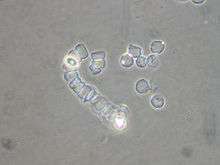Acrasidae
| Acrasid slime molds | |
|---|---|
 | |
| Acrasis rosea, amoebe and spores | |
| Scientific classification | |
| (unranked): | Excavata |
| Phylum: | Percolozoa |
| Class: | Heterolobosea |
| Order: | Acrasida |
| Family: | Acrasidae |
The family Acrasidae (ICZN, or Acrasiomycota, ICBN) is a family[1] of slime molds which belongs to the protist group Percolozoa. The name acrasio- comes from the Greek Akrasia, meaning "acting against one's judgement". This group consists of cellular slime molds.
Some would also consider it as a kingdom unto itself, but the debate is as yet unsettled.
The terms "Acrasiomycota" or "Acrasiomycetes" have been used when the group was believed to be a fungus ("-mycota"). In some classifications, Dictyostelium was placed in Acrasiomycetes, an artificial group of cellular slime molds, which was characterized by the aggregation of individual amoebae into a multicellular fruiting body, making it an important factor that related the acrasids to the dictyostelids.[2]
Reproduction
When resources such as water or food become limiting, the amoeba will release pheromones such as acrasin to aggregate amoebal cells in preparation for movement as a large (thousands of cells) grex or pseudopod. When in the grex, the amoeboids reproduce, resulting in fruit-like structures called spores, which develop into unicellular molds of the same species. .
See also
References
- ↑ Roger AJ, Smith MW, Doolittle RF, Doolittle WF (1996). "Evidence for the Heterolobosea from phylogenetic analysis of genes encoding glyceraldehyde-3-phosphate dehydrogenase". J. Eukaryot. Microbiol. 43 (6): 475–85. doi:10.1111/j.1550-7408.1996.tb04507.x. PMID 8976605.
- ↑ Cavender J.C.; Spiegl F.; Swanson A. (2002). "Taxonomy, slime molds, and the questions we ask". The Mycological Society of America. 96 (6): 968–979. PMID 21156570.
- C.J. Alexopolous, Charles W. Mims, M. Blackwell et al., Introductory Mycology, 4th ed. (John Wiley and Sons, Hoboken NJ, 2004) ISBN 0-471-52229-5